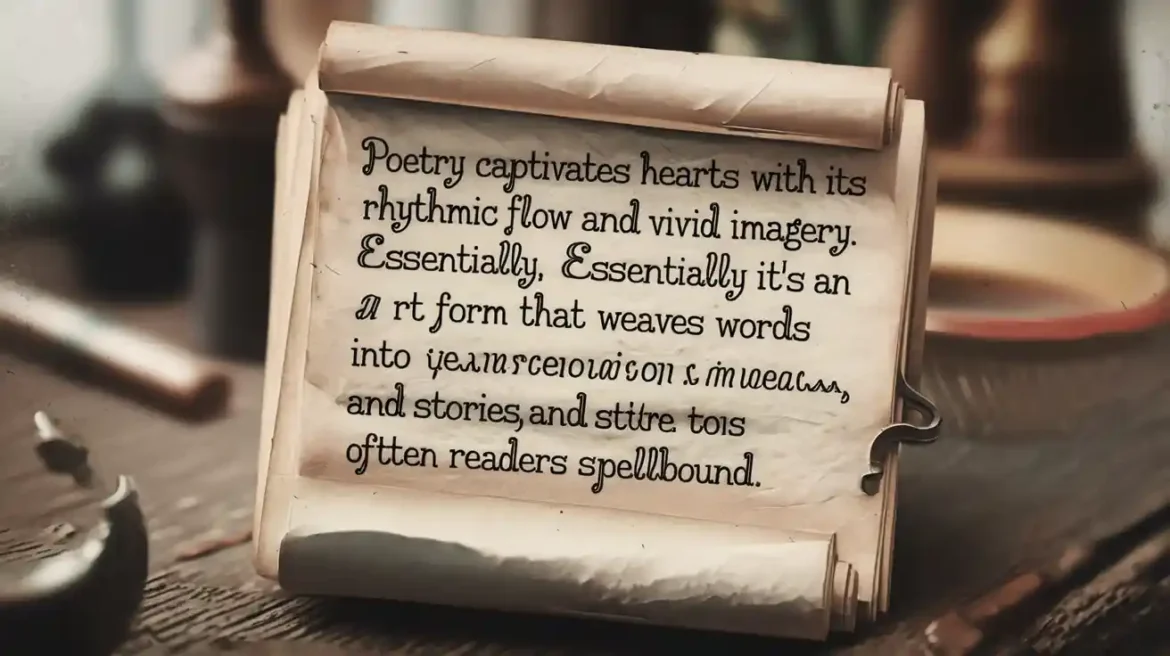
Poetry captivates hearts with its rhythmic flow and vivid imagery. Essentially, it’s an art form that weaves words into emotions, ideas, and stories, often leaving readers spellbound. Unlike prose, poetry thrives on concise expression, musicality, and layered meanings. Consequently, it invites readers to pause, reflect, and feel deeply. This article explores the poetry definition, its core elements, types, and significance in human culture. Additionally, it offers practical tips for crafting your own verses. Whether you’re a seasoned poet or a curious beginner, this guide, rooted in expertise, will illuminate the timeless beauty of poetry. Let’s dive into its enchanting world.
What Is the Definition of Poetry?
Poetry, at its core, is a literary art form that uses aesthetic and rhythmic language to evoke emotions, ideas, or experiences. Unlike everyday language, it prioritizes sound, structure, and figurative expressions. For instance, poets carefully select words to create vivid imagery or convey profound truths. Moreover, poetry often employs meter, rhyme, or specific forms like sonnets or haikus to enhance its musicality. According to literary experts, poetry’s essence lies in its ability to compress complex thoughts into concise, impactful lines. Therefore, it resonates deeply with readers, offering both intellectual and emotional stimulation. This unique blend of creativity and discipline distinguishes poetry from other writing forms.
The Historical Roots of Poetry
Poetry’s origins trace back to ancient civilizations, where it served as a vessel for storytelling and cultural preservation. For example, epic poems like The Iliad by Homer captured heroic tales in rhythmic verse. Similarly, ancient Sumerian hymns and Vedic chants used poetic forms for spiritual expression. Over time, poetry evolved across cultures, from Chinese Tang dynasty verses to medieval European ballads. Consequently, it became a universal medium for human experiences. Furthermore, poetry’s adaptability allowed it to thrive in oral traditions before written records. Today, its historical richness informs modern poetic styles, proving its enduring relevance. This deep-rooted legacy underscores poetry’s role in connecting generations.
Key Elements of Poetry
Poetry relies on distinct elements to create its magic. First, imagery paints vivid mental pictures, engaging the senses. For instance, a line like “the moon wept silver tears” evokes a clear visual. Second, sound—through rhyme, alliteration, or assonance—adds musicality. Additionally, meter provides rhythm, guiding the poem’s pace. Figurative language, like metaphors or similes, deepens meaning. Moreover, structure, such as stanzas or line breaks, shapes the poem’s flow. Finally, theme conveys the poem’s core message or emotion. By blending these elements, poets craft works that resonate universally. Understanding these components enhances appreciation and fuels creative writing.
Imagery: Painting with Words
Imagery is poetry’s heartbeat, transforming words into sensory experiences. Specifically, it uses descriptive language to evoke sights, sounds, or emotions. For example, a poet might describe “whispering pines under a crimson sky” to transport readers to a serene forest. Consequently, imagery fosters emotional connections, making abstract ideas tangible. Moreover, it engages all senses, from the scent of rain to the chill of a winter breeze. Skilled poets balance vivid imagery with concise wording to avoid overwhelming readers. Therefore, mastering imagery is crucial for impactful poetry. By practicing descriptive techniques, aspiring poets can create immersive worlds that linger in readers’ minds.
Rhythm and Meter: The Pulse of Poetry
Rhythm and meter give poetry its musical quality. Specifically, rhythm refers to the flow of stressed and unstressed syllables, while meter is the structured pattern, like iambic pentameter. For instance, Shakespeare’s sonnets often follow a da-DUM rhythm, creating a heartbeat-like cadence. Consequently, these elements enhance readability and emotional impact. Moreover, poets may vary rhythm to evoke specific moods—fast-paced for excitement, slow for melancholy. Understanding meter, though, requires practice, as it varies across poetic forms. By experimenting with syllable patterns, poets can craft verses that sing. Thus, rhythm and meter are essential tools for poetic expression.
Figurative Language: Beyond Literal Meaning
Figurative language elevates poetry by adding depth and nuance. Specifically, tools like metaphors, similes, and personification create layers of meaning. For example, saying “life is a stormy sea” conveys struggle more vividly than literal words. Consequently, figurative language invites readers to interpret poems creatively. Moreover, it allows poets to express complex emotions concisely. However, overuse can obscure meaning, so balance is key. By studying poets like Emily Dickinson or Langston Hughes, writers learn to wield figurative language effectively. Thus, this element transforms poetry into a rich tapestry of ideas, sparking imagination and emotional resonance.
Types of Poetry
Poetry comes in diverse forms, each with unique characteristics. For instance, lyric poetry expresses personal emotions, often in a musical style, like sonnets or odes. Conversely, narrative poetry tells stories, as seen in epics like Beowulf. Additionally, dramatic poetry involves character-driven dialogue, resembling plays. Meanwhile, haikus capture fleeting moments with a 5-7-5 syllable structure. Furthermore, free verse rejects traditional rules, prioritizing natural speech. Each type serves distinct purposes, from evoking feelings to preserving tales. By exploring these forms, poets find the best medium for their voice, enriching their creative expression.
Lyric Poetry: The Song of Emotions
Lyric poetry focuses on personal feelings and thoughts, often in a musical format. For example, sonnets or odes express love, grief, or awe with intense emotion. Historically, lyric poems were sung with a lyre, hence the name. Today, poets like Pablo Neruda use lyrical forms to explore intimate experiences. Consequently, this type resonates deeply with readers seeking emotional connection. Moreover, its flexible structure allows creative freedom within rhythmic patterns. By experimenting with lyric poetry, writers can channel raw emotions into polished verses. Thus, it remains a timeless form for capturing the human spirit.
Narrative Poetry: Stories in Verse
Narrative poetry weaves tales through rhythmic verse, blending storytelling with poetic flair. For instance, epics like The Odyssey or ballads like “The Rime of the Ancient Mariner” captivate with vivid plots. Consequently, this form preserves cultural histories and moral lessons. Moreover, it engages readers with characters, conflicts, and resolutions, much like prose. However, its rhythmic structure adds a lyrical quality prose lacks. By studying narrative poets like Chaucer, writers learn to balance plot and poetry. Thus, narrative poetry offers a unique way to tell compelling stories while harnessing the beauty of verse.
Free Verse: Breaking the Rules
Free verse poetry defies traditional structures, embracing natural speech rhythms. Unlike sonnets or haikus, it lacks consistent meter or rhyme. For example, Walt Whitman’s Leaves of Grass flows freely, mimicking human thought. Consequently, free verse offers unparalleled creative freedom, allowing poets to experiment boldly. Moreover, it suits modern themes, reflecting life’s unpredictability. However, effective free verse requires skillful word choice to maintain impact. By practicing this form, poets can explore unique voices without constraints. Thus, free verse remains a popular choice for contemporary poets seeking authenticity and innovation.
Why Poetry Matters
Poetry holds profound significance in human culture. Specifically, it fosters emotional connection, helping readers process complex feelings. For instance, poems about loss or love offer solace and understanding. Additionally, poetry sharpens critical thinking by encouraging interpretation of layered meanings. Moreover, it preserves cultural identities, from ancient epics to modern spoken word. Furthermore, poetry’s accessibility—through open mics or online platforms—democratizes art. According to studies, engaging with poetry boosts empathy and mental well-being. Therefore, it remains a vital tool for self-expression and social commentary. By embracing poetry, individuals connect with humanity’s shared experiences across time.
How to Write Poetry: Tips for Beginners
Writing poetry can feel daunting, but anyone can start with simple steps. First, read widely—explore poets like Maya Angelou or Rumi for inspiration. Next, focus on a single emotion or image to anchor your poem. Additionally, experiment with vivid imagery and concise wording. For instance, describe a sunset in five words. Moreover, play with rhythm by reading your work aloud. Furthermore, don’t fear revisions; great poems evolve over time. Finally, join poetry communities for feedback. By practicing consistently, beginners can craft meaningful verses. Thus, poetry becomes an accessible, rewarding outlet for creativity.
Finding Your Poetic Voice
Your poetic voice is your unique style, reflecting your perspective. To find it, write authentically about personal experiences. For example, journal about a childhood memory, then transform it into verse. Additionally, experiment with different forms, like haikus or free verse, to discover what resonates. Moreover, read diverse poets to broaden your influences. Consequently, your voice will emerge through consistent practice and reflection. However, avoid imitating others too closely—authenticity matters. By embracing vulnerability, you’ll craft poems that feel true. Thus, developing your voice is a journey of self-discovery, unlocking your creative potential.
Using Poetic Devices Effectively
Poetic devices enhance a poem’s impact when used thoughtfully. For instance, metaphors add depth, while alliteration boosts rhythm. However, balance is crucial—overuse can feel forced. Start by choosing one device, like a simile, and weaving it into a stanza. Next, read your poem aloud to ensure natural flow. Additionally, study poets like Robert Frost to see how devices elevate meaning. Moreover, revise ruthlessly to eliminate clichés. By practicing restraint and precision, your poems will resonate more powerfully. Thus, mastering poetic devices transforms simple words into art, captivating readers with every line.
Poetry in the Modern World
Poetry thrives today, adapting to digital platforms and diverse voices. For instance, Instagram poets like Rupi Kaur share bite-sized verses, reaching millions. Similarly, spoken word events amplify marginalized perspectives, fostering inclusivity. Moreover, poetry slams encourage live performances, blending art with community. Additionally, online journals and podcasts democratize access, inviting new poets to emerge. Consequently, poetry remains a dynamic force, reflecting modern struggles and joys. Furthermore, its brevity suits fast-paced lives, offering quick yet profound insights. By engaging with contemporary poetry, readers and writers connect with today’s cultural pulse, proving its timeless relevance.
FAQs
What is the simplest definition of poetry?
Poetry is a literary art form using rhythmic, aesthetic language to express emotions, ideas, or experiences concisely.
How does poetry differ from prose?
Unlike prose’s straightforward narrative, poetry emphasizes rhythm, imagery, and figurative language, often in structured or free verse.
Can anyone write poetry?
Yes! Anyone can write poetry by experimenting with words, emotions, and forms. Practice and reading poets help refine skills.
What are common poetry forms?
Common forms include sonnets, haikus, free verse, and narrative poems, each with unique structures and purposes.
Why is poetry still relevant today?
Poetry connects people emotionally, preserves culture, and adapts to modern platforms like social media, amplifying diverse voices.
Conclusion:
Poetry’s beauty lies in its ability to distill human experiences into powerful, concise words. From ancient epics to modern Instagram verses, it remains a timeless art form. By understanding its definition, elements, and types, you can appreciate its depth and versatility. Moreover, writing poetry unlocks creativity, fostering emotional and intellectual growth. Whether you’re reading classic sonnets or crafting your own free verse, poetry offers a unique lens on life. So, grab a pen, explore your emotions, and start writing today. Visit poetry communities or share your work online to join this vibrant art form’s legacy!


